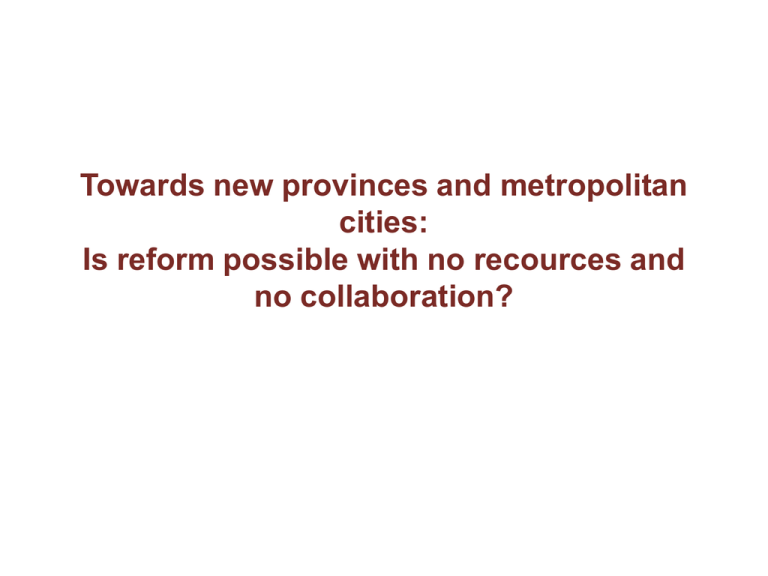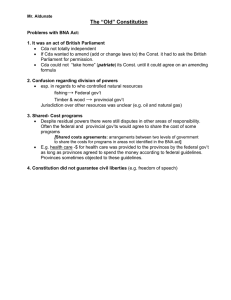Towards new provinces and metropolitan cities: no collaboration?
advertisement

Towards new provinces and metropolitan cities: Is reform possible with no recources and no collaboration? Regions, provinces and municipalities are the three levels of the Italian Government. A province of the Italian Republic is composed of mani municipalities (comuni). Unsually several provinces together form a region. In 1861 at the birth of the kingdom of Italy, there were 59 provinces. In 1927, following a royal charter, a general province rearrangement took place. 17 new provinces were created. New provinces were created in 1934, 1935, 1941, 1947, 1968,1970, 1974, 1992, 2001, 2005. The result was 107 provinces. Provinces manage responsibilities such as: roads’ maintenance, local transportation, school buildings, culture and tourism. Cities usually take care of welfare, environment, housing and urban planning. The new law does not say exactly how all these roles should be merged, leaving cities and their suburbs to work out the details on their own. Negotiations have been going on across the country for months. Provincial public expenditure In the past 5 years, provincial public expenditure has amounted to €12 billion each year. In 2011 it was €11 billion. Approximately ¼ covers personnel expenditures of 60.000 provincial employees. In 2011 Mario Monti the Italian prime minister suggested that all provinces should be abolished and their administrative duties supplanted by the 20 Italian Regions but, not surprisingly, nothing happened after this declaration. Few months later the government approved a decree that abolished 40 provinces, including: 1. Sardinia lost 6 out of its 8 provinces 2. Tuscany 5 out of its 10 3. Sicily 2 out of 9 4. Umbria 1 out of its 2 5. Molise lost both its provinces 6. Marche 2 out of 5 7. Calabria 3 out of 5 8. Liguria 3 out of 4 9. Friluli 2 out of 4 10. Veneto 2 out of 5 This was an extremely controversial proposal, with very significant political, financial, administrative and HR consequences. One-third of the Italian provinces were to be abolished. Not surprisingly, there was strong resistance from regions and affected provinces, as well as labour unions and local politicians. Significant modifications to the legislative proposal were to be expected. This proposal was abolished by the Constitutional Court in 2013 because the reform does not made by decree. On 3 April 2014, the Italian Chamber of Deputies gave its final approval to the Law n.56/2014 which involves the transformation of the Italian provinces into "second-level bodies" and the birth of 10 special Metropolitan cities. [The reorganization to be operative by January 2015]. The new law which transforms the provinces is aimed at their abolition, as a revision of the second part of the Italian Constitution is needed in order to change the current bicameral parliamentary system and to abolish. The Delrio Reforms (by the name of minister) represent a significant reshuffling of power in Italy. Traditionally, there have been four levels of government here: national, regional, provincial and city, leading to complaints of too much red tape. Under the new law, the provinces will essentially disappear, at least in the 14 areas where the new metropolitan cities are being established. In other parts of the country, provinces will remain but with a diminished role. “This is the first true institutional reform based on cities and municipalities” Turin Mayor and current ANCI president Piero Fassino said as the Italian Parliament gave its final vote. Cities “are institutions closer to citizens and more appreciated by them.” Metropolitan cities (CM) • 12 metropolitan cities have been established • The territory of the CM is the same as the province • Functions include: – Strategic planning – Territorial planning – Local public services – Mobility and traffic – Economic development • Governance is based on second level election (the president of CM is the mayor of the main municipality and the council is composed by mayors of the municipalities of the territory). Provinces • Governance redefined through second level election (president ad council composed by a specific number of mayors of the municipalities of the territory). • Functions of provinces include: – Territorial planning – Transportation planning – School construction and planning of school networks – Assistance to municipalities • These functions are defined by State law. Regions with an own law must define additional functions delegated to provinces (the law must be adopted by 31/12/14) • In September 2014, through an agreement between the State and regions, regionals observatories to manage the transformation process were established. Union of municipalities • The law encourages unions of municipalities and mergers • The main feature of DELRIO’s law is that it leaves regions and municipalities free to decide which functions are entrusted to the provinces. Every function delegated to the province must be paid by delegator agencies. • The government, in relation to the reduction of functions of provinces, cut €1 billion in 2015, €2 billion in 2016 and €3,5 billion in 2017. • The same law provides for the redistribution of half of the employees to other levels of government or agencies. What has happened so far • The new provinces were established with the election of new presidents and councils But… • Only 3 regions have enacted the necessary laws • The provinces are non able to change their services and their organizations as a lot of them are in financial crisis. The implementation of the reform is in serious danger The reform is blocked • The functions are not defined today and no one takes the responsibility to do so • The resources are not sufficient to secure the services of the past and no one takes responsibility to redefine them • Employees have not been reallocated and soon may be no resources to pay their salaries • The observatories are not working well The (general) question • What is better: reform by law (top- down) or reform by leadership considered like a change management process (bottom up)? • Is possible to finance reforms with resources coming from efficiency gains?





